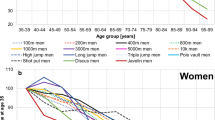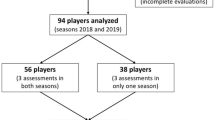Abstract
Purpose
To compare and assess differences in the career performance progressions of elite junior and Olympic track and field athletes.
Methods
Annual best performances from top 8 men and women (e.g. finalists) in track and field events at the 2000 World Junior Championships (junior cohort) and the 2000 Olympic Games (Olympic cohort) were examined. Annual bests of these finalists were tracked each year from select groups: sprints (100 m, 200 m), distance (1500 m, 5000 m), jumps (long jump, high jump), throws (discus, shot put). Age of best lifetime performance, age of final posted performance, and improvement from junior-age best to lifetime best performance were compared between groups.
Results
Olympic finalists achieved lifetime best performances at later ages than junior finalists [26.0 ± 4.0 years vs. 21.1 ± 3.5 years; age difference 90% CI (3.7–5.2 years), P < 0.001], and this significant age difference between cohorts was found within all four groups. Olympic finalists improved from under-20 best to lifetime best more so than junior finalists [6.1 ± 4.8% vs. 2.5 ± 2.3%; Age difference 90% CI (2.5–4.8%), P < 0.001]. Of 130 junior finalists, 54 did not improve after age 19, while 19 of 128 Olympic finalists posted no improvement after age 19.
Conclusion
The data suggest that these two populations have different career performance progressions and challenge the notion that achieving elite success as a junior athlete is a prerequisite for the same success at the senior level.


Similar content being viewed by others
References
Alfermann D, Stambulova N. Career transitions and career termination. In: Tenebaum G, Eklund R, editors. Handbook of sport psychology, vol. 3. 3rd ed. New York: Wiley; 2007. p. 712–33.
Baker J, Cote J, Abernethy B. Sport-specific practice and the development of expert decision-making in team ball sports. J Appl Sport Psychol. 2003;15(1):12–25.
Baxter-Jones ADG, Maffulli N. Parental influence on sport participation in elite young athletes. J Sports Med Phys Fitn. 2003;43(2):250.
Baxter-Jones ADG, Thompson AM, Malina RM. Growth and maturation in elite young female athletes. Sports Med Arthrosc Rev. 2002;10(1):42–9.
Bennie A, O’Connor D. Athletic transition: an investigation of elite track and field participation in the post-high school years. Change Transform Educ. 2006;9(1):59–68.
Beunen G, Malina RM. Growth and biologic maturation: relevance to athletic performance. In: Hebestreit H, Bar-Or O, editors. The young athlete. Oxford: Blackwell; 2008. p. 3–17.
Cobley S, Baker J, Wattie N, McKenna J. Annual age-grouping and athlete development: a meta-analytical review of relative age effects in sport. Sports Med. 2009;39(3):235–56.
Côté J, Baker J, Abernethy B. Practice and play in the development of sport expertise. In: Tenebaum G, Eklund R, editors. Handbook of sport psychology, vol. 3. New York: Wiley; 2007. p. 184–202.
Cumming G, Garand T, Borysyk L. Correlation of performance in track and field events with bone age. J Pediatr. 1972;80(6):970–3.
Ericsson KA. Deliberate practice and acquisition of expert performance: a general overview. Acad Emerg Med. 2008;15(11):988–94.
Ericsson KA, Krampe RT, Tesch-Römer C. The role of deliberate practice in the acquisition of expert performance. Psychol Rev. 1993;100:363.
Ford PR, Ward P, Hodges NJ, Williams AM. The role of deliberate practice and play in career progression in sport: the early engagement hypothesis. High Ability Stud. 2009;20(1):65–75.
Frisch RE, Gotz-Welbergen AV, McArthur JW, Albright T, Witschi J, Bullen B, Birnholz J, Reed RB, Hermann H. Delayed menarche and amenorrhea of college athletes in relation to age of onset of training. J Am Med Assoc. 1981;246(14):1559–63.
Ginsburg RD, Smith SR, Danforth N, Ceranoglu TA, Durant SA, Kamin H, Babcock R, Robin L, Masek B. Patterns of specialization in professional baseball players. J Clin Sport Psychol. 2014;8(3):261–75.
Grund M, Ritzdorf W. From talent to elite athlete: a study of the performance development of the finalists at the 1999 IAAF World Youth Athletics Championships. New Stud Athl. 2006;21(2):43.
Gulbin J, Weissensteiner J, Oldenziel K, Gagné F. Patterns of performance development in elite athletes. Eur J Sport Sci. 2013;13(6):605–14.
Hata E, Aoki K. Age at menarche and selected menstrual characteristics in young Japanese athletes. Res Q Exerc Sport. 1990;61(2):178–83.
Hirose N. Relationships among birth-month distribution, skeletal age and anthropometric characteristics in adolescent elite soccer players. J Sports Sci. 2009;27:1159–66.
Hollings S. World junior success is a prerequisite for world senior success. Mod Athl Coach. 2006;44(1):14–7.
Hollings S, Hopkins W, Hume P. Age at peak performance of successful track and field athletes. Int J Sports Sci Coach. 2014;9(4):651–61.
Hollings S, Hume P. Is success at the World Junior Athletics Championships a prerequisite for success at World Senior Championships or Olympic Games? Prospective and retrospective analyses. New Stud Athl. 2010;25(2):65–77.
Hollings S, Mallett C, Hume P. The transition from elite junior track-and-field athlete to successful senior athlete: why some do, why others don’t. Int J Sports Sci Coach. 2014;9(3):457–72.
Julin A. Where have all the flowers gone. In: Matthews P, editor. Athletics. Surbiton: SportsBooks Ltd; 1995. p. 140–2.
Macnamara BN, Hambrick DZ, Oswald FL. Deliberate practice and performance in music, games, sports, education, and professions a meta-analysis. Psychol Sci. 2014;25:1608–18.
Malina RM. Delayed age of menarche of athletes. J Am Med Assoc. 1982;247(24):3312.
Malina RM, Beunen G, Wellens R, Claessens A. Skeletal maturity and body size of teenage Belgian track and field athletes. Ann Hum Biol. 1986;13(4):331–9.
Malina RM, Katzmarzyk PT, Bonci CM, Ryan RC, Wellens RE. Family size and age at menarche in athletes. Med Sci Sports Exerc. 1997;29(1):99–106.
Malina RM, Rogol AD, Cumming SP, Silva MJCE, Figueiredo AJ. Biological maturation of youth athletes: assessment and implications. Br J Sports Med. 2015;49(13):852–9.
Malina RM, Spirduso WW, Tate C, Baylor AM. Age at menarche and selected menstrual characteristics in athletes at different competitive levels and in different sports. Med Sci Sports Exerc. 1977;10(3):218–22.
Moesch K, Elbe AM, Hauge ML, Wikman J. Late specialization: the key to success in centimeters, grams, or seconds (cgs) sports. Scand J Med Sci Sports. 2011;21(6):e282–90.
Mostafavifar AM, Best TM, Myer GD. Early sport specialisation, does it lead to long-term problems? Br J Sports Med. 2013;47(17):1060–1.
Musch J, Grondin S. Unequal competition as an impediment to personal development: a review of the relative age effect in sport. Dev Rev. 2001;21:147–67.
Oldenziel K, Gagne F, Gulbin J. Factors affecting the rate of athlete development from novice to senior elite: how applicable is the 10-year rule. In: Athens pre-Olympic congress; 2004. Retrieved Oct. http://cev.org.br/biblioteca/factors-affecting-the-rate-of-athlete-development-from-novice-to-senior-elite-how-applicable-is-the-10-year-rule/.
Piacentini MF, Comotto S, Guerriero A, Bonato M, Vernillo G, La Torre A. Does the junior IAAF athletic world championship represent a springboard for the success in the throwing events? A retrospective study. J Sports Med Phys Fitn. 2014;54:410–6.
Raschner C, Muller L, Hildebrandt C. The role of a relative age effect in the first winter Youth Olympic Games in 2012. Br J Sports Med. 2012;46(15):1038–43.
Scholz W. The throwing events at the IAAF World Junior Championships: a whistle stop on the journey to elite athletics. New Stud Athl. 2006;21(2):7.
Stager JM, Robertshaw D, Miescher E. Delayed menarche in swimmers in relation to age at onset of training and athletic performance. Med Sci Sports Exerc. 1984;16(6):550–5.
Stambulova N, Alfermann D, Cote J, Statler T. Career development and transitions of athletes. In: 12th European congress of sport psychology. FEPSAC European Federation of Sport Psychology; 2007.
Suslov F. Current problems in the development of young athletes. New Stud Athl. 2008;23(3):19–25.
Zelichenok V. The long-term competition activity of the world’s top athletes. New Stud Athl. 2005;20(2):19–24.
Author information
Authors and Affiliations
Contributions
JLF and RFC: significant manuscript writer. Significant manuscript reviewer/reviser. Concept and design. Data acquisition. Data analysis and interpretation. Statistical expertise. JAS: significant manuscript writer. Significant manuscript reviewer/reviser. Concept and design. Statistical expertise.
Corresponding author
Rights and permissions
About this article
Cite this article
Foss, J.L., Sinex, J.A. & Chapman, R.F. Career Performance Progressions of Junior and Senior Elite Track and Field Athletes. J. of SCI. IN SPORT AND EXERCISE 1, 168–175 (2019). https://doi.org/10.1007/s42978-019-0013-8
Received:
Accepted:
Published:
Issue Date:
DOI: https://doi.org/10.1007/s42978-019-0013-8




